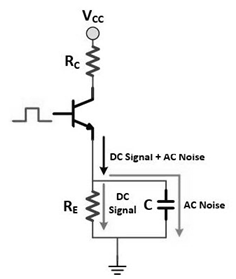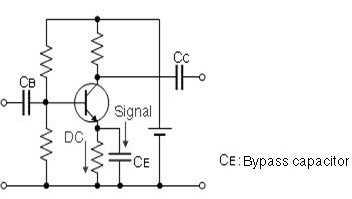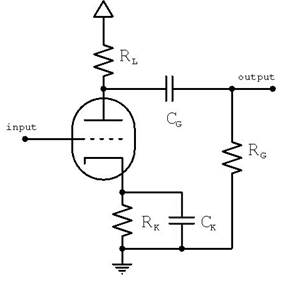A capacitor is a device that can be used to store electric energy. It has two terminals and its effect is called capacitance. A capacitor basically consists of two metal plates that act as a conductor with a dielectric medium in between. The conductor may be in the form of electrodes or metal plates or thin foil. The dielectric material is used to increase the capacitance. There are different types of capacitors and a bypass capacitor is one of them. It is a component in an electric circuit that is placed between the power supply VCC and the ground GND in the circuit. It can be used to reduce the power supply noise. It can also be used to provide current supply to the integrated circuits that require a large supply of current.
What is a Bypass Capacitor?
It is a type of capacitor which is used to produce a clean DC signal. It shorts the AC signals to the ground such that the AC noise present on the DC signal can be easily removed thus producing a proper DC signal. It can bypass the AC noise to produce a better quality signal. It filters out the AC and removes the AC ripples to produce a clean DC signal. Thus, it is basically a filtering device.

bypass-capacitor
Here in the diagram, we can see that the capacitor conducts AC and the AC is regularly removed from an AC/DC combination. After that, the DC can freely pass through the bypassed components.
Types Of Bypass Capacitors
There are different types of bypass capacitors which include the following.
Emitter Type
If we add an emitter resistance in a Common Emitter amplifier circuit, the voltage gain of the amplifier is greatly reduced. However, the input impedance of the amplifier increases. When we connect a bypass capacitor and an emitter resistance in parallel connection, the voltage gain of the Common Emitter amplifier increases. If we remove this capacitor from the circuit, it results in an extreme degeneration in the amplifier circuit and this will lead to the reduction of voltage gain in the amplifier.

emitter-bypass-capacitor
Cathode Type
In the case of a cathode type, the cathode resistor which is present in a triode preamp is bypassed within a very large capacitor. This eliminates the negative feedback. This is also called cathode degeneration which can greatly increase the voltage gain.

cathode-bypass-capacitor
If the capacitor used is sufficiently large, it is capable of acting as a short circuit for audio frequencies. It can then eliminate the negative feedback. It can also act as an open circuit for direct current. In this way, it can maintain the DC grid bias. We can also introduce a treble boost in the circuit. This can be done by lowering the capacitor value of the capacitor which acts as a short circuit. This operation is mainly done in the preamp’s bright channel. If an extra gain is achieved, then we can eliminate the capacitor completely from the circuit.
Functions:
The most important function of a bypass capacitor is that it can be used to bypass the AC signal to the ground. The capacitor is connected between a wire and the ground. If an AC signal is received by the capacitor, then the capacitor performs short on the AC signal and bypasses it completely. The capacitor behaves as an open circuit for a DC signal. The DC signal is directly fed to the integrated circuit.
Some of the important characteristics of the bypass capacitor which makes it an important electric component have been mentioned below:
- The impedance of this capacitor is very low.
- It can be used to electrify an electric circuit.
- It can be used to ground the noise current.
- It can decrease the amount of noise current in the circuit.
Applications of a bypass capacitor
A bypass capacitor can be used for the following purposes:
- Power factor correction and Power conditioning
- Real-time clock calendar
- DC/DC Converter
- Voltage Reference
- DSL Amplifiers
- Signal coupling
- Signal Decoupling
- High pass filter and low pass filter
Thus, this is all about an overview of a bypass capacitor, it can be considered as a very essential component of an electric circuit. It can be used to lower the high-frequency noise in the circuit which is generally produced by the other circuits. The inductance value plays an important role in determining the efficiency of the bypass capacitor. Therefore, we should choose a bypass capacitor for our circuit based on the inductance of the capacitor. Here, the inductance plays a much more important role than the capacitance.
The bypass capacitor should be kept close to the integrated circuits which require a very large amount of current. The capacitor should have very low inductance and series resistance which is functional only at higher frequencies.
FAQs
1). What is the difference between the bypass capacitor and the coupling capacitor?
Coupling capacitors are basically used to decouple the dc and when ac signals are given as input to the circuit. They make sure that the quiescent points of the circuit are not disturbed. On the other hand, the bypass capacitor removes the ac ripples from the dc signal thereby providing a very low impedance path.
Coupling Capacitor is used to soothen the signal whereas bypass capacitor is used to shunt the signal.
2). What is an electronic bypass?
An electronic bypass refers to the process of providing an alternate path to the flow of electric current in a circuit. In this capacitor, the ac signals are bypassed.
3). What will happen if the bypass capacitor is removed?
If we remove the bypass capacitor from our circuit, an extreme degeneration will be produced in the circuit as a result of which the voltage gain in the amplifier circuit will also be reduced.
4). What is the effect of the bypass capacitor?
The most important effect of a bypass capacitor is that it can be used to remove power supply noise. It is also used to produce clean DC signals by removing AC ripples from it. The bypass capacitor is placed between the VCC and the GND in the electric circuit.
5). How do find the value of bypasscapacitor ?
The value of the bypasscapacitor can be calculated using the formula
C = 1/(2PiFXc) where Pi =3.14, F= frequency of the electical signal which is generally various per country and Xc is the reactance. When a bypass capacitor is connected across a resistor then the reactance would be 1/10 of the resistor. i.e. Xc = resistance/10.
Please refer to this link to know more about Filter Capacitor.